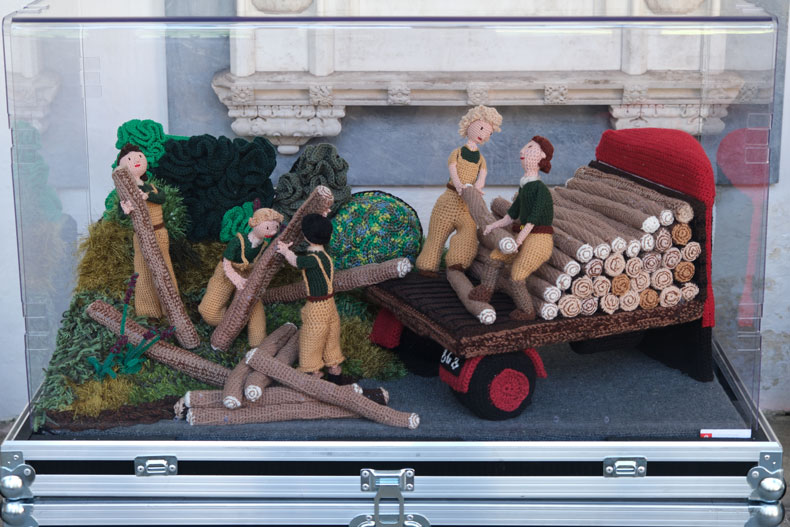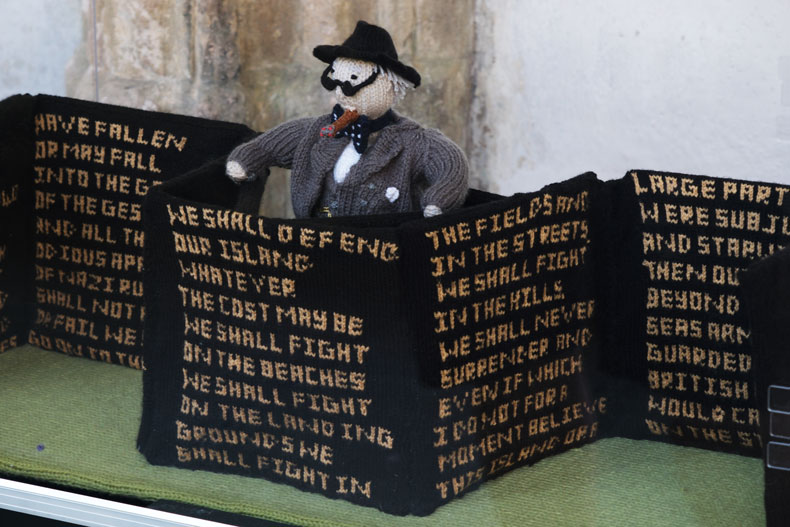As popular as films about the D-Day landings tend to be, they don’t tend to have sequels; we never did find out what Private Ryan got up to after the war. But the rules that apply to cinema don’t necessarily apply to the world of craft.
In 2024, to commemorate the 80th anniversary of the D-Day landings, retired Normandy resident Tansy Forster organised The Longest Yarn, an 80-metre-long knitted depiction of the landings that paid homage to the Hollywood film The Longest Day (1962). Now her sequel, The Longest Yarn 2: Britain at War – which relates scenes from the UK’s home front between September 1939 and VE Day – has touched down at Wells Cathedral.
Normans have form in commemorating battles in fabric, the Bayeux Tapestry being the most famous example. But there is always something delightful about seeing great figures of history transformed by knitting and crochet – just think of the craze for making figures of Queen Elizabeth II and her corgis. In this latest exhibition, Rakewell is particularly fond of the ‘lumberjills’ hauling logs on to a truck. The attention to detail is extraordinary: in one panel, Churchill’s ‘We shall fight them on the beaches’ speech is knitted out word for word.

The ‘lumberjills’ in a panel from The Longest Yarn 2: Britain at War (2024–25). Courtesy Wells Cathedral
While legend long had it that the Bayeux Tapestry was embroidered by William the Conqueror’s wife Queen Matilda and her ladies in waiting (the actual makers, who were likely based in England, are unknown), The Longest Yarn and its follow-up have depended on volunteers. The youngest crocheters are eight years old, and the eldest is 92. One panel took more than 800 hours: the knitters realised halfway through that the brown boots of some of the characters had to be unpicked and changed to black for the sake of historical accuracy.
Although the exhibition at Wells Cathedral seems comprehensive, it is in fact only part of the work: Forster and the knitters will be adding more panels as they complete them. Or, as Rakewell likes to think of it, adding scenes to the sequel. This story is not confined to Wells: like all the great releases, it will also be on show in the United States. Rakewell has only one concern: having chronicled D-Day and the UK at war, what will these knitters take on next?

Winston Churchill delivers his ‘We shall fight them on the beaches’ speech in a panel from The Longest Yarn 2: Britain at War (2024–25). Courtesy Wells Cathedral





 The Donald who didn’t like Nazis
The Donald who didn’t like Nazis








![Masterpiece [Re]discovery 2022. Photo: Ben Fisher Photography, courtesy of Masterpiece London](http://zephr.apollo-magazine.com/wp-content/uploads/2022/07/MPL2022_4263.jpg)
Why it’s time to stop rediscovering Eileen Gray